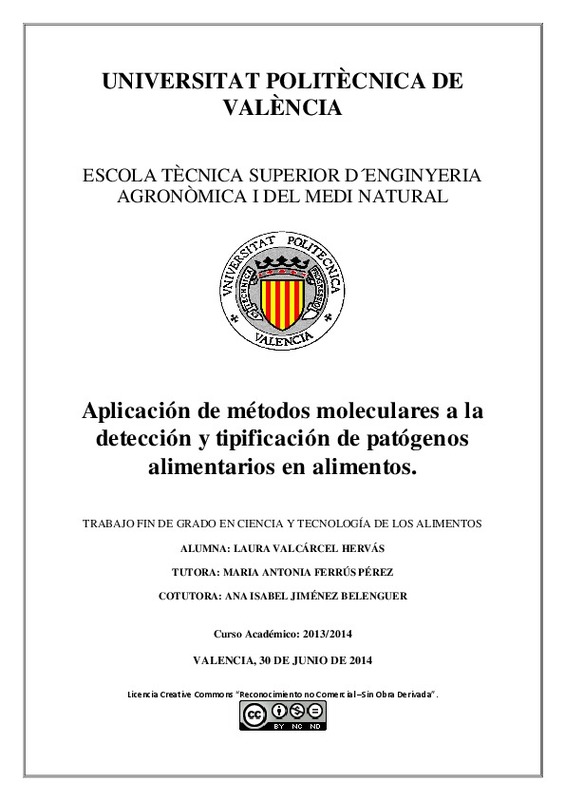|
Resumen:
|
[EN] Diseases transmitted by microorganisms in food are an important public health problem. These have all kinds of microorganism pathogenic and non-pathogenic, between them is include bacteria pertaining to the genus ...[+]
[EN] Diseases transmitted by microorganisms in food are an important public health problem. These have all kinds of microorganism pathogenic and non-pathogenic, between them is include bacteria pertaining to the genus Salmonella, Escherichia coli, and Arcobacter, which is considered an emerging pathogen. This study is centred in the investigation of the presence of these bacteria in samples of minced meat of chicken in the market and the determination of its microbiological quality.
On the other hand, the antibiotic abuse in animal husbandry is a one of the factors for the sprouting of resistant bacteria to these compounds.The World Health Organization (WHO) estimates that if measures are not taken, resistant bacteria could not be treat with the antibiotic agents commonly used. This problematic led us to raise a series of objectives in this study, among them, make a sampling in stores of Valencia to determine the contamination of indicator microorganisms, as well as the possible presence of pathogens, in agreement with the Spanish legislation for this type of products, studying concretely the presence of mesophilic aerobes, Escherichia coli and Salmonella. Also, was determined the presence of emergent pathogens of genus Arcobacter. The analyses were made by means of the use of cultural methods and, for the case of Arcobacter and Salmonella, was used molecular techniques like the Chain reaction of Polymerase (PCR), being made a comparative one of the results by both techniques. Finally, for the isolated of Escherichia coli, was studied the possible microbial resistance forehead to several antibiotics by means of the method of antibiogram dial-plate.
Of the 7 samples analyzed in this work, one of them (14.29%) gave an unacceptable count of mesófilos aerobes and in four of them (57.14%) they obtained isolated from Escherichia coli. All of them presented multiresistance to antibiotics commonly used, being observed the higher percentage of resistance front Amoxicilina, Ampicilina, Nalidíxico Acid, Ciprofloxacino and to Cefalotina. Was not detected Salmonella or Arcobacter by means of cultural methods. For the analyses made by PCR technique (Reaction of the Polymerase in Chain) they were obtained directly aliquot from the sample homogenised with a broth of selective enrichment and after incubating the broth during 48 hours. By means of this technique one was not able to detect no bacterium of the Arcobactergenus, however Salmonella was detected in two samples (28.57%), after the phase of enrichment.
[-]
[ES] Las enfermedades transmitidas por microorganismos presentes en los alimentos son un problema de salud pública importante. Estos presentan toda clase de microorganismos patógenos y no patógenos, entre los que se encuentra ...[+]
[ES] Las enfermedades transmitidas por microorganismos presentes en los alimentos son un problema de salud pública importante. Estos presentan toda clase de microorganismos patógenos y no patógenos, entre los que se encuentra las bacterias pertenecientes al género Salmonella, Escherichiacoli y Arcobacter, que se considera un patógeno emergente. Este estudio se centra en la investigación de la presencia de estas bacterias en muestras de carne picada de pollo presentes en el mercado y en la determinación de su calidad microbiológica. Por otro lado, el abuso de antibióticos en ganadería es uno de los factores para el surgimiento de bacterias resistentes a estos compuestos. La Organización Mundial de la Salud (OMS) considera que si no se toman medidas, las bacterias resistentes no podrán ser tratadas con los agentes antibióticos comúnmente utilizados. Esta problemática nos llevó a plantearnos una serie de objetivos en este estudio, entre ellos, realizar un muestreo en comercios de Valencia para determinar la contaminación de microorganismos indicadores, así como la posible presencia de patógenos, de acuerdo con la legislación española para este tipo de productos, estudiando concretamente la presencia de aerobios mesófilos, Escherichiacoliy Salmonella. Se determinó también la presencia de patógenos emergentes del género Arcobacter. Los análisis se realizaron mediante el empleo de métodos culturales y, para el caso de Arcobacter y Salmonella, se emplearontécnicas moleculares como la Reacción en Cadena de la Polimerasa (PCR), realizándose una comparativa de los resultados por ambas técnicas. Por último, para las cepas aisladas de Escherichiacoli, se estudiaron las posibles resistencias microbianas frente a varios antibióticos mediante el método del antibiograma disco-placa.
[-]
|







